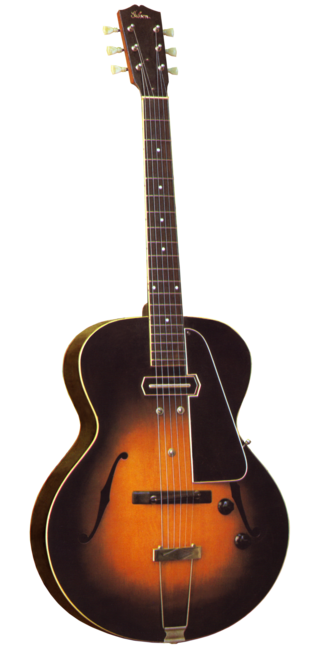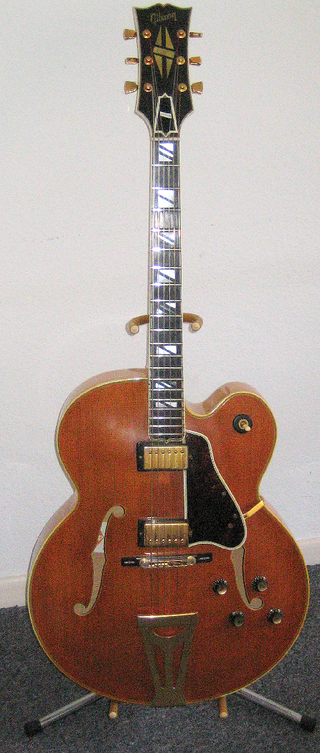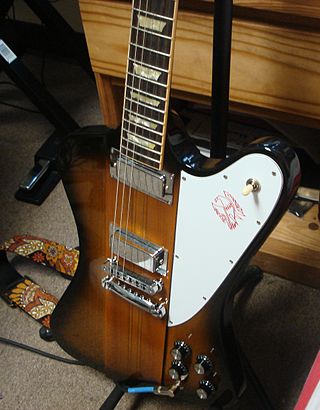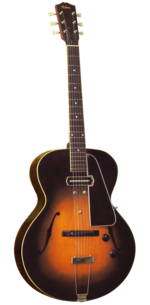
An electric guitar is a guitar that requires external amplification in order to be heard at typical performance volumes, unlike a standard acoustic guitar. It uses one or more pickups to convert the vibration of its strings into electrical signals, which ultimately are reproduced as sound by loudspeakers. The sound is sometimes shaped or electronically altered to achieve different timbres or tonal qualities from that of an acoustic guitar via amplifier settings or knobs on the guitar. Often, this is done through the use of effects such as reverb, distortion and "overdrive"; the latter is considered to be a key element of electric blues guitar music and jazz and rock guitar playing. Designs also exist combining attributes of the electric and acoustic guitars: the semi-acoustic and acoustic-electric guitars.

The guitar is a fretted musical instrument that typically has six strings. It is usually held flat against the player's body and played by strumming or plucking the strings with the dominant hand, while simultaneously pressing selected strings against frets with the fingers of the opposite hand. A plectrum or individual finger picks may also be used to strike the strings. The sound of the guitar is projected either acoustically, by means of a resonant chamber on the instrument, or amplified by an electronic pickup and an amplifier.
Rickenbacker International Corporation is a string instrument manufacturer based in Santa Ana, California. The company is credited as the first known maker of electric guitars – a steel guitar in 1932 – and today produces a range of electric guitars and basses.

A humbucking pickup, humbucker, or double coil, is a type of guitar pickup that uses two wire coils to cancel out the noisy interference picked up by coil pickups. In addition to electric guitar pickups, humbucking coils are sometimes used in dynamic microphones to cancel electromagnetic hum. Humbuckers are one of the two main types of guitar pickups. The other is single coil.

An electric piano is a musical instrument that has a piano-style musical keyboard, where sound is produced by means of mechanical hammers striking metal strings or reeds or wire tines, which leads to vibrations which are then converted into electrical signals by pickups. The pickups are connected to an instrument amplifier and loudspeaker to reinforce the sound sufficiently for the performer and audience to hear. Unlike a synthesizer, the electric piano is not an electronic instrument. Instead, it is an electro-mechanical instrument. Some early electric pianos used lengths of wire to produce the tone, like a traditional piano. Smaller electric pianos used short slivers of steel to produce the tone. The earliest electric pianos were invented in the late 1920s; the 1929 Neo-Bechstein electric grand piano was among the first. Probably the earliest stringless model was Lloyd Loar's Vivi-Tone Clavier. A few other noteworthy producers of electric pianos include Baldwin Piano and Organ Company, and the Wurlitzer Company.

A single coil pickup is a type of magnetic transducer, or pickup, for the electric guitar and the electric bass. It electromagnetically converts the vibration of the strings to an electric signal. Single coil pickups are one of the two most popular designs, along with dual-coil or "humbucking" pickups.

A semi-acoustic guitar, also known as a hollow-body electric guitar, is a type of electric guitar designed to be played with a guitar amplifier featuring a fully or partly hollow body and at least one electromagnetic pickup. First created in the 1930s, they became popular in jazz and blues, where they remain widely used, and the early period of rock & roll, though they were later largely supplanted by solid-body electric guitars in rock.

An archtop guitar is a hollow acoustic or semi-acoustic guitar with a full body and a distinctive arched top, whose sound is particularly popular with jazz, blues, and rockabilly players.

A pickup is a transducer that captures or senses mechanical vibrations produced by musical instruments, particularly stringed instruments such as the electric guitar, and converts these to an electrical signal that is amplified using an instrument amplifier to produce musical sounds through a loudspeaker in a speaker enclosure. The signal from a pickup can also be recorded directly.

Lloyd Allayre Loar (1886–1943) was an American musician, instrument designer and sound engineer. He is best known for his design work with the Gibson Mandolin-Guitar Mfg. Co. Ltd. in the early 20th century, including the F-5 model mandolin and L-5 guitar. In his later years he worked on electric amplification of stringed instruments, and demonstrated them around the country. One example, played in public in 1938 was an electric viola that used electric coils beneath the bridge, with no back, able to "drown out the loudest trumpet."

The Gibson Firebird is a solid-body electric guitar manufactured by Gibson beginning in 1963.

The P-90 is a single coil electric guitar pickup produced by Gibson Guitar Corporation since 1946, as well as other vendors. Compared to other single coil designs, such as the ubiquitous Fender single coil, the bobbin for a P-90 is wider but shorter. The Fender style single coil is wound in a taller bobbin, but the wires are closer to the individual poles. This makes the P-90 produce a different type of tone, somewhat warmer with less edge and brightness. As with other single-coil pickups, the P-90 is subject to mains hum unless some form of hum cancellation is used.

A P.A.F., or simply PAF, is an early model of the humbucker guitar pickup invented by Seth Lover in 1955, so named for the "Patent Applied For" decal placed on the baseplate of each pickup. Gibson used the PAF on guitars from late 1956 until late 1962, long after the patent was granted. They were replaced by the Patent Number pickup, essentially a refined version of the PAF. These were in turn replaced by "T-Top" humbuckers in 1967, and production ended in 1975. Though it was not the first humbucking pickup ever, it was the first to gain widespread use, as the PAF's hum-free signal, tonal clarity, and touch sensitivity when paired with higher-gain amplifiers made the pickups popular with rock and blues guitarists. The PAF is an essential tonal characteristic of the now-famous 1957–1960 Gibson Les Paul Standard guitars, and pickups of this type have gained a large following.
The Gibson Les Paul Junior is a solid-body electric guitar introduced in 1954 as an affordable, entry-level Les Paul. It was first released with a single-cutaway body style; models with a double-cutaway body style were later introduced in 1958. The Junior continued through the first three years of the Les Paul/SG body redesign. The initial run was discontinued in 1963.

The Gibson ES-135 is a semi-hollow body electric guitar made by the Gibson Guitar Corporation. Originally introduced in 1956, it was discontinued in 1958. Some guitars were stamped with and marketed as an ES-130. The original run amounted to 556 instruments produced. The model, with some modifications, was reintroduced in 1991 and remained in production until 2004.
Electric guitar design is a type of industrial design where the looks and efficiency of the shape as well as the acoustical aspects of the guitar are important factors. In the past many guitars have been designed with various odd shapes as well as very practical and convenient solutions to improve the usability of the object.
The Gibson ES series of semi-acoustic guitars are manufactured by the Gibson Guitar Corporation.

The Fender Noiseless series is a line of electric guitar pickups made by the Fender Musical Instruments Corporation designed to cancel 60 cycle (Hz) hum noise while retaining the characteristic sound of single coil pickups. Introduced in 1998, these pickups consist of a pair of single coils stacked one on top of the other, compacted so as to match the shape and width space as a traditional Fender single coil guitar pickup, while being only slightly taller. The upper coil is actually the sound source, while the lower coil is responsible for the 60-cycle hum attenuation. Alnico V magnetic bars span from one coil to the other, crossing a soft ferrous steel spacer plate that isolates them, without touching it. The spacer plate has mainly two functions: to isolate the lower coil from the vibrations of the string, making sure that the sound is picked up only from the upper one, and to increase the magnetic flux that passed through both coils, increasing the output of the pickup. This is to be contrasted with the original noise canceling pickup, the humbucker, which is a double-wide, horizontally adjacent pair of single coil pickups with opposing phase.

Classical electric guitars, also known as nylon-string electric guitars, represent a unique fusion of traditional classical guitar design and modern electric guitar technology. These instruments combine the rich and warm tonal qualities of nylon-stringed classical guitars with the versatility and amplified sound capabilities of electric guitars. By integrating nylon strings with onboard electronics, pickups, and preamp systems, classical electric guitars offer musicians a wide range of sonic possibilities for various musical genres and performance settings.
The Fender Telecaster, colloquially known as the Tele, is an electric guitar produced by Fender. Together with its sister model the Esquire, it was the world's first mass-produced, commercially successful solid-body electric guitar. Its simple yet effective design and revolutionary sound broke ground and set trends in electric guitar manufacturing and popular music.

















